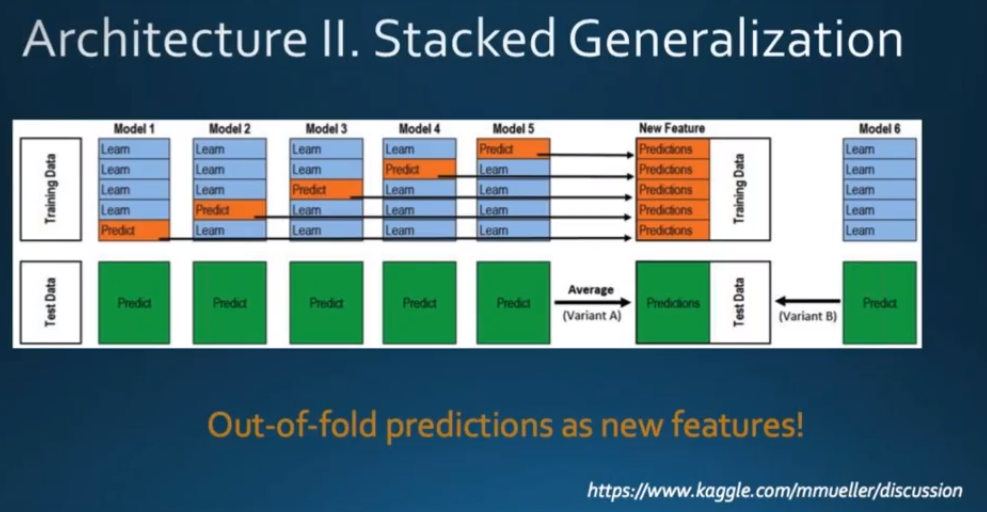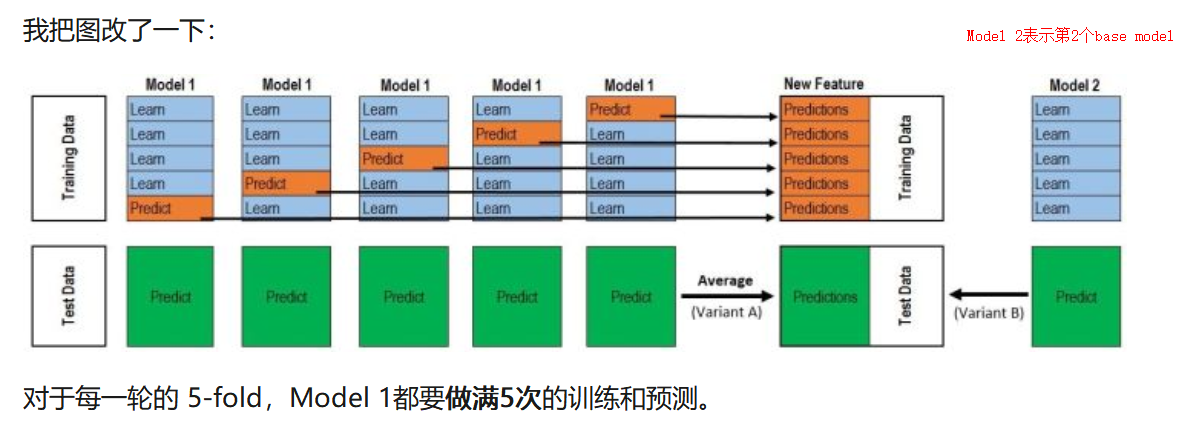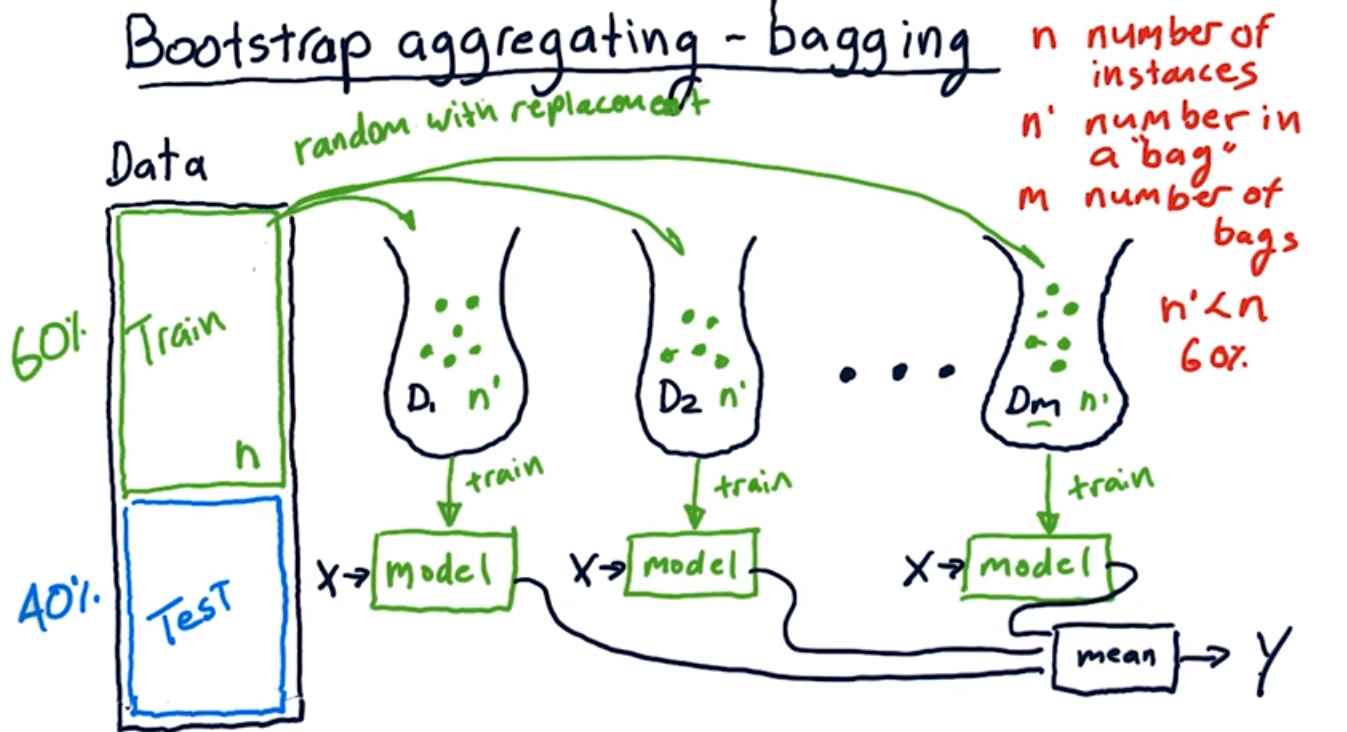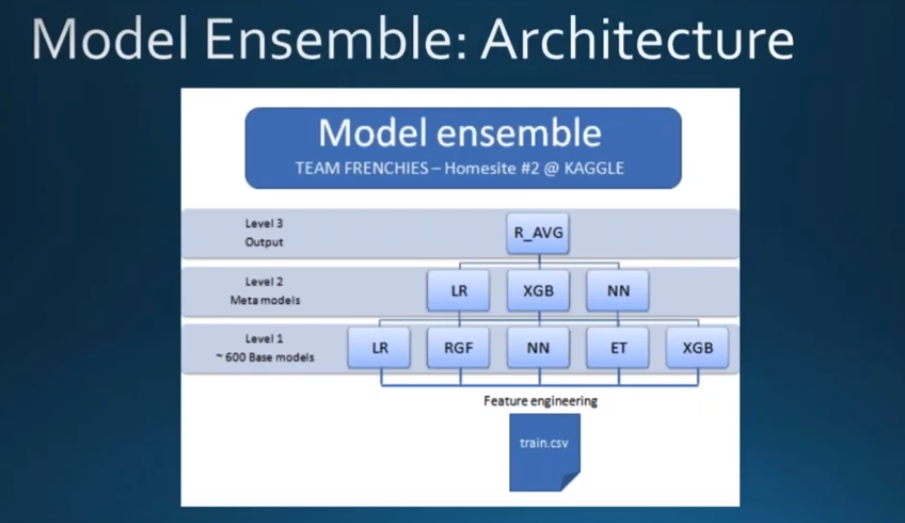模型融合之blending和stacking
1. blending
- 需要得到各个模型结果集的权重,然后再线性组合。
"""Kaggle competition: Predicting a Biological Response.
Blending {RandomForests, ExtraTrees, GradientBoosting} + stretching to
[0,1]. The blending scheme is related to the idea Jose H. Solorzano
presented here:
http://www.kaggle.com/c/bioresponse/forums/t/1889/question-about-the-process-of-ensemble-learning/10950#post10950
'''You can try this: In one of the 5 folds, train the models, then use
the results of the models as 'variables' in logistic regression over
the validation data of that fold'''. Or at least this is the
implementation of my understanding of that idea :-)
The predictions are saved in test.csv. The code below created my best
submission to the competition:
- public score (25%): 0.43464
- private score (75%): 0.37751
- final rank on the private leaderboard: 17th over 711 teams :-)
Note: if you increase the number of estimators of the classifiers,
e.g. n_estimators=1000, you get a better score/rank on the private
test set.
Copyright 2012, Emanuele Olivetti.
BSD license, 3 clauses.
"""
from __future__ import division
import numpy as np
import load_data
from sklearn.cross_validation import StratifiedKFold
from sklearn.ensemble import RandomForestClassifier, ExtraTreesClassifier
from sklearn.ensemble import GradientBoostingClassifier
from sklearn.linear_model import LogisticRegression
def logloss(attempt, actual, epsilon=1.0e-15):
"""Logloss, i.e. the score of the bioresponse competition.
"""
attempt = np.clip(attempt, epsilon, 1.0-epsilon)
return - np.mean(actual * np.log(attempt) +
(1.0 - actual) * np.log(1.0 - attempt))
if __name__ == '__main__':
np.random.seed(0) # seed to shuffle the train set
n_folds = 10
verbose = True
shuffle = False
X, y, X_submission = load_data.load()
if shuffle:
idx = np.random.permutation(y.size)
X = X[idx]
y = y[idx]
skf = list(StratifiedKFold(y, n_folds))
clfs = [RandomForestClassifier(n_estimators=100, n_jobs=-1, criterion='gini'),
RandomForestClassifier(n_estimators=100, n_jobs=-1, criterion='entropy'),
ExtraTreesClassifier(n_estimators=100, n_jobs=-1, criterion='gini'),
ExtraTreesClassifier(n_estimators=100, n_jobs=-1, criterion='entropy'),
GradientBoostingClassifier(learning_rate=0.05, subsample=0.5, max_depth=6, n_estimators=50)]
print ("Creating train and test sets for blending.")
dataset_blend_train = np.zeros((X.shape[0], len(clfs)))
dataset_blend_test = np.zeros((X_submission.shape[0], len(clfs)))
for j, clf in enumerate(clfs):
print (j, clf)
dataset_blend_test_j = np.zeros((X_submission.shape[0], len(skf)))
for i, (train, test) in enumerate(skf):
print ("Fold", i)
X_train = X[train]
y_train = y[train]
X_test = X[test]
y_test = y[test]
clf.fit(X_train, y_train)
y_submission = clf.predict_proba(X_test)[:, 1]
dataset_blend_train[test, j] = y_submission
dataset_blend_test_j[:, i] = clf.predict_proba(X_submission)[:, 1]
dataset_blend_test[:, j] = dataset_blend_test_j.mean(1)
print()
print( "Blending.")
clf = LogisticRegression()
clf.fit(dataset_blend_train, y)
y_submission = clf.predict_proba(dataset_blend_test)[:, 1]
print( "Linear stretch of predictions to [0,1]")
y_submission = (y_submission - y_submission.min()) / (y_submission.max() - y_submission.min())
print( "Saving Results.")
tmp = np.vstack([range(1, len(y_submission)+1), y_submission]).T
np.savetxt(fname='submission.csv', X=tmp, fmt='%d,%0.9f',
header='MoleculeId,PredictedProbability', comments='')
2.stacking
- stacking的核心:在训练集上进行预测,从而构建更高层的学习器。
- stacking训练过程:
1) 拆解训练集。将训练数据随机且大致均匀的拆为m份。
2)在拆解后的训练集上训练模型,同时在测试集上预测。利用m-1份训练数据进行训练,预测剩余一份;在此过程进行的同时,利用相同的m-1份数据训练,在真正的测试集上预测;如此重复m次,将训练集上m次结果叠加为1列,将测试集上m次结果取均值融合为1列。
3)使用k个分类器重复2过程。将分别得到k列训练集的预测结果,k列测试集预测结果。
4)训练3过程得到的数据。将k列训练集预测结果和训练集真实label进行训练,将k列测试集预测结果作为测试集。
# -*- coding: utf-8 -*-
import numpy as np
from sklearn.model_selection import StratifiedKFold
from sklearn.svm import SVC
from sklearn.ensemble import RandomForestClassifier
from sklearn.neighbors import KNeighborsClassifier
import xgboost as xgb
from sklearn.ensemble import ExtraTreesClassifier
from sklearn.linear_model import LogisticRegression
def load_data():
pass
def stacking(train_x, train_y, test):
""" stacking
input: train_x, train_y, test
output: test的预测值
clfs: 5个一级分类器
dataset_blend_train: 一级分类器的prediction, 二级分类器的train_x
dataset_blend_test: 二级分类器的test
"""
# 5个一级分类器
clfs = [SVC(C = 3, kernel="rbf"),
RandomForestClassifier(n_estimators=100, max_features="log2", max_depth=10, min_samples_leaf=1, bootstrap=True, n_jobs=-1, random_state=1),
KNeighborsClassifier(n_neighbors=15, n_jobs=-1),
xgb.XGBClassifier(n_estimators=100, objective="binary:logistic", gamma=1, max_depth=10, subsample=0.8, nthread=-1, seed=1),
ExtraTreesClassifier(n_estimators=100, criterion="gini", max_features="log2", max_depth=10, min_samples_split=2, min_samples_leaf=1,bootstrap=True, n_jobs=-1, random_state=1)]
# 二级分类器的train_x, test
dataset_blend_train = np.zeros((train_x.shape[0], len(clfs)), dtype=np.int)
dataset_blend_test = np.zeros((test.shape[0], len(clfs)), dtype=np.int)
# 5个分类器进行8_folds预测
n_folds = 8
skf = StratifiedKFold(n_splits=n_folds, shuffle=True, random_state=1)
for i,clf in enumerate(clfs):
dataset_blend_test_j = np.zeros((test.shape[0], n_folds)) # 每个分类器的单次fold预测结果
for j,(train_index,test_index) in enumerate(skf.split(train_x, train_y)):
tr_x = train_x[train_index]
tr_y = train_y[train_index]
clf.fit(tr_x, tr_y)
dataset_blend_train[test_index, i] = clf.predict(train_x[test_index])
dataset_blend_test_j[:, j] = clf.predict(test)
dataset_blend_test[:, i] = dataset_blend_test_j.sum(axis=1) // (n_folds//2 + 1)
# 二级分类器进行预测
clf = LogisticRegression(penalty="l1", tol=1e-6, C=1.0, random_state=1, n_jobs=-1)
clf.fit(dataset_blend_train, train_y)
prediction = clf.predict(dataset_blend_test)
return prediction
def main():
(train_x, train_y, test) = load_data()
prediction = stacking(train_x, train_y, test)
return prediction
if __name__ == "__main__":
prediction = main()
ensemble model
比较简明的资源有:
- 1.https://zhuanlan.zhihu.com/p/26890738
- 2.数据应用学院 Kaggle案例实战 公开课 Part 2 https://www.youtube.com/watch?v=BS4SY3HhVDI&t=4320s

上面的是以5折为例,如果是2折的话就更简单了!

-----------------------------------------------------分割线------------------------------------------------------------------

- 以Kaggle的泰坦尼克号为例子
# out-of-Fold Prdictions
TrainingData = train.shape[0] # 891行
TestData = test.shape[0] # 418 行
# 5 折
kf = KFold(n_splits = 5, random_state = 2017)
# X_train, y_train, X_test表示原生的数据
def get_oof(clf, X_train, y_train, X_test):
# oof_train对应于训练数据集TrainingData
oof_train = np.zeros((TrainingData, )) # 1 * 891型
# oof_test对应于测试集TestData
oof_test = np.zeros((TestData, )) # 1 * 418型
# oof_test_skf对应于5折之后的所有predict作为新的TestData(测试集),只要最后对行(axis = 0)取平均就得到平均predict值Test Data
oof_test_skf = np.empty((5, TestData)) # 5 * 418型
for i, (train_index, test_index) in enumerate(kf.split(X_train)):
# kf_X_train 表示train data每一折中用于训练的训练集(4份共有712个样本)
kf_X_train = X_train[train_index] # 712 * 7 例如712 instances for each fold
kf_y_train = y_train[train_index] # 712 * 1 例如712 instances for each fold
# kf_X_test 表示train data每一折中用于predict的数据集(也就是验证集validation data)
kf_X_test = X_train[test_index] # 179 * 7 例如178 instances for each fold
clf.train(kf_X_train, kf_y_train) # 训练模型
# 得到predict值(输出值)作为new feature输入用于第二层的训练
# 一个base model 就对应于new feature的一列,此时的new feature有多少列取决于你第一层用了多少个base model
oof_train[test_index] = clf.prdict(kf_X_test) # 1 * 179 ===> will be 1 * 891 after 5 folds
# 用TestData --这里X_test(测试集)用于预测
oof_test_skf[i, :] = clf.predict(X_test) # oof_test_skf[i, :],1 * 418 ===> will be 5 * 418 after 5 folds
# 5折stacking结束后
# 对测试集预测得到的predict值进行行(axis = 0)平均: 5 * 418 ===> 1 * 418
oof_test[:] = oof_test_skf.mean(axis = 0)
return oof_train.reshpae(-1, 1), oof_test.reshpae(-1, 1)
# oof_train.reshpae(-1, 1): 891 * 1 oof_test.reshpae(-1, 1): 418 * 1
-------------------------------------------------补充----------------------------------------------
Udacity的几张图


模型融合之blending和stacking的更多相关文章
- 模型融合——stacking原理与实现
一般提升模型效果从两个大的方面入手 数据层面:数据增强.特征工程等 模型层面:调参,模型融合 模型融合:通过融合多个不同的模型,可能提升机器学习的性能.这一方法在各种机器学习比赛中广泛应用, 也是在比 ...
- 深度学习模型融合stacking
当你的深度学习模型变得很多时,选一个确定的模型也是一个头痛的问题.或者你可以把他们都用起来,就进行模型融合.我主要使用stacking和blend方法.先把代码贴出来,大家可以看一下. import ...
- 深度学习模型stacking模型融合python代码,看了你就会使
话不多说,直接上代码 def stacking_first(train, train_y, test): savepath = './stack_op{}_dt{}_tfidf{}/'.format( ...
- 谈谈模型融合之一 —— 集成学习与 AdaBoost
前言 前面的文章中介绍了决策树以及其它一些算法,但是,会发现,有时候使用使用这些算法并不能达到特别好的效果.于是乎就有了集成学习(Ensemble Learning),通过构建多个学习器一起结合来完成 ...
- 在Caffe中实现模型融合
模型融合 有的时候我们手头可能有了若干个已经训练好的模型,这些模型可能是同样的结构,也可能是不同的结构,训练模型的数据可能是同一批,也可能不同.无论是出于要通过ensemble提升性能的目的,还是要设 ...
- Gluon炼丹(Kaggle 120种狗分类,迁移学习加双模型融合)
这是在kaggle上的一个练习比赛,使用的是ImageNet数据集的子集. 注意,mxnet版本要高于0.12.1b2017112. 下载数据集. train.zip test.zip labels ...
- 模型融合策略voting、averaging、stacking
原文:https://zhuanlan.zhihu.com/p/25836678 1.voting 对于分类问题,采用多个基础模型,采用投票策略选择投票最多的为最终的分类. 2.averaging 对 ...
- 基于sklearn的 BaseEstimator开发接口:模型融合Stacking
转载:https://github.com/LearningFromBest/CMB-credit-card-department-prediction-of-purchasing-behavior- ...
- 22(8).模型融合---RegionBoost
在adaboost当中,样本的权重alpha是固定的,蓝色五角星所在的圈中3个○分错了,红色五角星所在的圈中4个×和1个○都分对了,很容易让人想到,这个模型,对于红色位置的判断更加可信. 动态权重,每 ...
随机推荐
- ios --跳转到支付宝
//跳转到支付宝 - (BOOL)webView:(UIWebView *)webView shouldStartLoadWithRequest:(NSURLRequest *)request nav ...
- es6 async与await实战
在使用js的时候,我们经常会遇到一个问题,就是我们需要等待请求返回再做下一步处理,之前的处理方式是通过ajax的success或者callback之类的方法,不过一层一层真的恶心,而且只是针对单个页面 ...
- PowerDesigner之设置(3)——根据Name首字母生成Code
SQL版本:2000 PowerDesigner版本:16 网上有不少介绍 PowerDesigner Name/Code自动调整 的文章,但基本如出一辙. 这里,我就介绍下如何根据输入的Name根据 ...
- 【BZOJ2186】[Sdoi2008]沙拉公主的困惑 线性筛素数
[BZOJ2186][Sdoi2008]沙拉公主的困惑 Description 大富翁国因为通货膨胀,以及假钞泛滥,政府决定推出一项新的政策:现有钞票编号范围为1到N的阶乘,但是,政府只发行编号与M! ...
- 《从零开始学Swift》学习笔记(Day2)——使用Web网站编写Swift代码
Swift 2.0学习笔记——使用Web网站编写Swift代码 原创文章,欢迎转载.转载请注明:关东升的博客 Swift程序不能在Windows其他平台编译和运行,有人提供了一个网站swiftstub ...
- 将DataTable转换成Json格式
方法一: 将DataTable数据拼接成json字符串,方法如下: ///<summary> /// dataTable转换成Json格式 ///</summary> ///& ...
- [Node.js] require背后的故事
前言 熟悉Node.js的肯定对下面的代码熟悉 var http = require('http'); 这段代码很好理解,就是加载一个http模块.但是你有没有想过为什么要这么写?这其中的缘由是什么呢 ...
- 用JS改变的元素CSS样式,css里display :none 隐藏 block 显示
CSS样式的引用有3种方式:style引用.class引用.id引用,所以js改变元素的样式我们也分3种来说. 1.js改变由style方式引用的样式:方法一:document.divs.style. ...
- 巨蟒python全栈开发django8:基于对象和基于双下划线的多表查询
1.编辑删除&&多对多关系的其他方法 提交,数据,得到结果 查看运行 给编辑和删除,添加样式 我们点击删除,可以成功删除 打印sql语句的,在settings.py里边的配置 LOGG ...
- 通过less 计算 得出图片均分布局
<style lang="less"> @import "../style/weui.wxss"; // WXSS · 小程序 https://de ...

